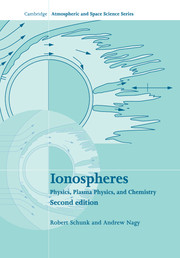Book contents
- Frontmatter
- Contents
- Chapter 1 Introduction
- Chapter 2 Space environment
- Chapter 3 Transport equations
- Chapter 4 Collisions
- Chapter 5 Simplified transport equations
- Chapter 6 Wave phenomena
- Chapter 7 Magnetohydrodynamic formulation
- Chapter 8 Chemical processes
- Chapter 9 Ionization and energy exchange processes
- Chapter 10 Neutral atmospheres
- Chapter 11 The terrestrial ionosphere at middle and low latitudes
- Chapter 12 The terrestrial ionosphere at high latitudes
- Chapter 13 Planetary ionospheres
- Chapter 14 Ionospheric measurement techniques
- Appendix A Physical constants and conversions
- Appendix B Vector relations and operators
- Appendix C Integrals and transformations
- Appendix D Functions and series expansions
- Appendix E Systems of units
- Appendix F Maxwell transfer equations
- Appendix G Collision models
- Appendix H Maxwell velocity distribution
- Appendix I Semilinear expressions for transport coefficients
- Appendix J Solar fluxes and relevant cross sections
- Appendix K Atmospheric models
- Appendix L Scalars, vectors, dyadics, and tensors
- Appendix M Radio wave spectrum
- Appendix N Simple derivation of continuity equation
- Appendix O Numerical solution for F region ionization
- Appendix P Monte Carlo methods
- Index
Chapter 7 - Magnetohydrodynamic formulation
Published online by Cambridge University Press: 22 January 2010
- Frontmatter
- Contents
- Chapter 1 Introduction
- Chapter 2 Space environment
- Chapter 3 Transport equations
- Chapter 4 Collisions
- Chapter 5 Simplified transport equations
- Chapter 6 Wave phenomena
- Chapter 7 Magnetohydrodynamic formulation
- Chapter 8 Chemical processes
- Chapter 9 Ionization and energy exchange processes
- Chapter 10 Neutral atmospheres
- Chapter 11 The terrestrial ionosphere at middle and low latitudes
- Chapter 12 The terrestrial ionosphere at high latitudes
- Chapter 13 Planetary ionospheres
- Chapter 14 Ionospheric measurement techniques
- Appendix A Physical constants and conversions
- Appendix B Vector relations and operators
- Appendix C Integrals and transformations
- Appendix D Functions and series expansions
- Appendix E Systems of units
- Appendix F Maxwell transfer equations
- Appendix G Collision models
- Appendix H Maxwell velocity distribution
- Appendix I Semilinear expressions for transport coefficients
- Appendix J Solar fluxes and relevant cross sections
- Appendix K Atmospheric models
- Appendix L Scalars, vectors, dyadics, and tensors
- Appendix M Radio wave spectrum
- Appendix N Simple derivation of continuity equation
- Appendix O Numerical solution for F region ionization
- Appendix P Monte Carlo methods
- Index
Summary
The 13-moment system of transport equations was presented in Chapter 3 and several associated sets of collision terms were derived in Chapter 4. These 13-moment transport equations, in combination with the Maxwell equations for the electric and magnetic fields, are very general and can be applied to describe a wide range of plasma flows in the ionospheres. However, the complete system of equations for a multi-species plasma is difficult to solve under most circumstances, and therefore, simplified sets of transport equations have been used over the years. The simplified sets of equations that are based on the assumption of collision dominance were presented in Chapter 5. In this chapter, certain simplified transport equations are derived in which the plasma is treated as a single conducting fluid, rather than a mixture of individual plasma species. These single-fluid transport equations, along with the Maxwell equations, are known as the single-fluid magnetohydrodynamic (MHD) equations.
The outline of this chapter is as follows. First, the single-fluid transport equations are derived from the 13-moment system of equations. Subsequently, a generalized Ohm's law is derived for a fully ionized plasma. This naturally leads to simplifications that yield the classical set of MHD equations. The classical MHD equations are then applied to important specific cases, including a discussion of pressure balance, the diffusion of a magnetic field into a plasma, the concept of a B field frozen in a plasma, the derivation of the spiral magnetic field associated with rotating magnetized bodies, and the derivation of the double-adiabatic energy equations for a collisionless anisotropic plasma. These topics are followed by a derivation of the MHD waves and shocks that can exist in a plasma.
- Type
- Chapter
- Information
- IonospheresPhysics, Plasma Physics, and Chemistry, pp. 206 - 230Publisher: Cambridge University PressPrint publication year: 2009
- 2
- Cited by

